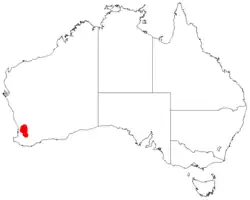Acacia cuneifolia
| Acacia cuneifolia | |
|---|---|
| Scientific classification | |
| Kingdom: | Plantae |
| Clade: | Tracheophytes |
| Clade: | Angiosperms |
| Clade: | Eudicots |
| Clade: | Rosids |
| Order: | Fabales |
| Family: | Fabaceae |
| Subfamily: | Caesalpinioideae |
| Clade: | Mimosoid clade |
| Genus: | Acacia |
| Species: | A. cuneifolia
|
| Binomial name | |
| Acacia cuneifolia | |

| |
| Occurrence data from AVH | |
| Synonyms[1] | |
| |
Acacia cuneifolia is a species of flowering plant in the family Fabaceae and is endemic to the south-west of Western Australia. It is an erect or straggly shrub with sometimes hairy branchlets, hairy clusters of variably-shaped phyllodes with a sharp point on the end, more or less spherical heads of golden yellow flowers and curved to coiled, glabrous pods.
Description
Acacia cuneifolia is an erect or straggly shrub that typically grows to a height of 1–3 m (3 ft 3 in – 9 ft 10 in). Its branchlets are sometimes glabrous sometimes hairy. The phyllodes are sometimes arranged in clusters and are variably shaped, often with one side straight and the other side curved, wedge-shaped or oblong, 8–25 mm (0.31–0.98 in) long and 2–6 mm (0.079–0.236 in) wide with a sharp point on the end. There are stipules 1–3 mm (0.039–0.118 in) long at the base of the phyllodes, more or less spiny with age but often only with the base persisting. The flowers are borne in up to six, more or less spherical heads on a peduncle 5–20 mm (0.20–0.79 in) long, the heads 3.5–4.5 mm (0.14–0.18 in) in diameter with 23 to 25 golden yellow flowers. Flowering has been recorded in September and October, and the pods are strongly curved to coiled, up to 50 mm (2.0 in) long and 4.5–5.5 mm (0.18–0.22 in) wide and glabrous. The seeds are oblong to slightly elliptic, 4–5 mm (0.16–0.20 in) long, dull, dark brown with a cream-coloured aril on the end.[2][3][4][5][6]
Taxonomy
Acacia cuneifolia was first formally described in 1999 the journal Nuytsia by Bruce Maslin from specimens he collected on Pony Hill, 18 km (11 mi) due south-west of York in 1987.[2][7] The specific epithet (cuneifolia) means 'wedge-leaved', referring to the shape of the phyllodes.[8]
Distribution
This species of wattle grows in dark brown clay and coarse sand on granite rocks near the type location, about halfway between Perth and Brookton, and in the Boyagin Rock Reserve[3] in the Avon Wheatbelt and Jarrah Forest bioregions of south-western Western Australia.[6]
Conservation status
Acacia cuneifolia is listed as "Priority Four" by the Government of Western Australia, Department of Biodiversity, Conservation and Attractions,[6] meaning that is rare or near threatened.[9]
See also
References
- ^ a b "Acacia cuneifolia". Australian Plant Census. Retrieved 10 August 2025.
- ^ a b Maslin, Bruce R. (1999). "Acacia miscellany 16. The taxonomy of fifty-five species of Acacia, primarily Western Australian, in section Phyllodineae (Leguminosae: Mimosoideae)". Nuytsia. 12 (3): 339–340. Retrieved 11 August 2025.
- ^ a b Maslin, Bruce R. Kodela, Phillip G. (ed.). "Acacia cuneifolia". Flora of Australia. Australian Biological Resources Study, Department of Climate Change, Energy, the Environment and Water: Canberra. Retrieved 11 August 2025.
- ^ "Acacia cuneifolia". World Wide Wattle. Western Australian Herbarium. Retrieved 19 April 2019.
- ^ "Acacia cuneifolia". Australian Biological Resources Study. Retrieved 11 August 2025.
- ^ a b c "Acacia cuneifolia". FloraBase. Western Australian Government Department of Biodiversity, Conservation and Attractions.
- ^ "Acacia cuneifolia". APNI. Retrieved 11 August 2025.
- ^ George, Alex S.; Sharr, Francis A. (2023). Western Australian Plant Names and Their Meanings - A Glossary (fifth ed.). Kardinya: Four Gables Press. p. 177. ISBN 9780645629538.
- ^ "Conservation codes for Western Australian Flora and Fauna" (PDF). Government of Western Australia Department of Parks and Wildlife. Retrieved 11 August 2025.
